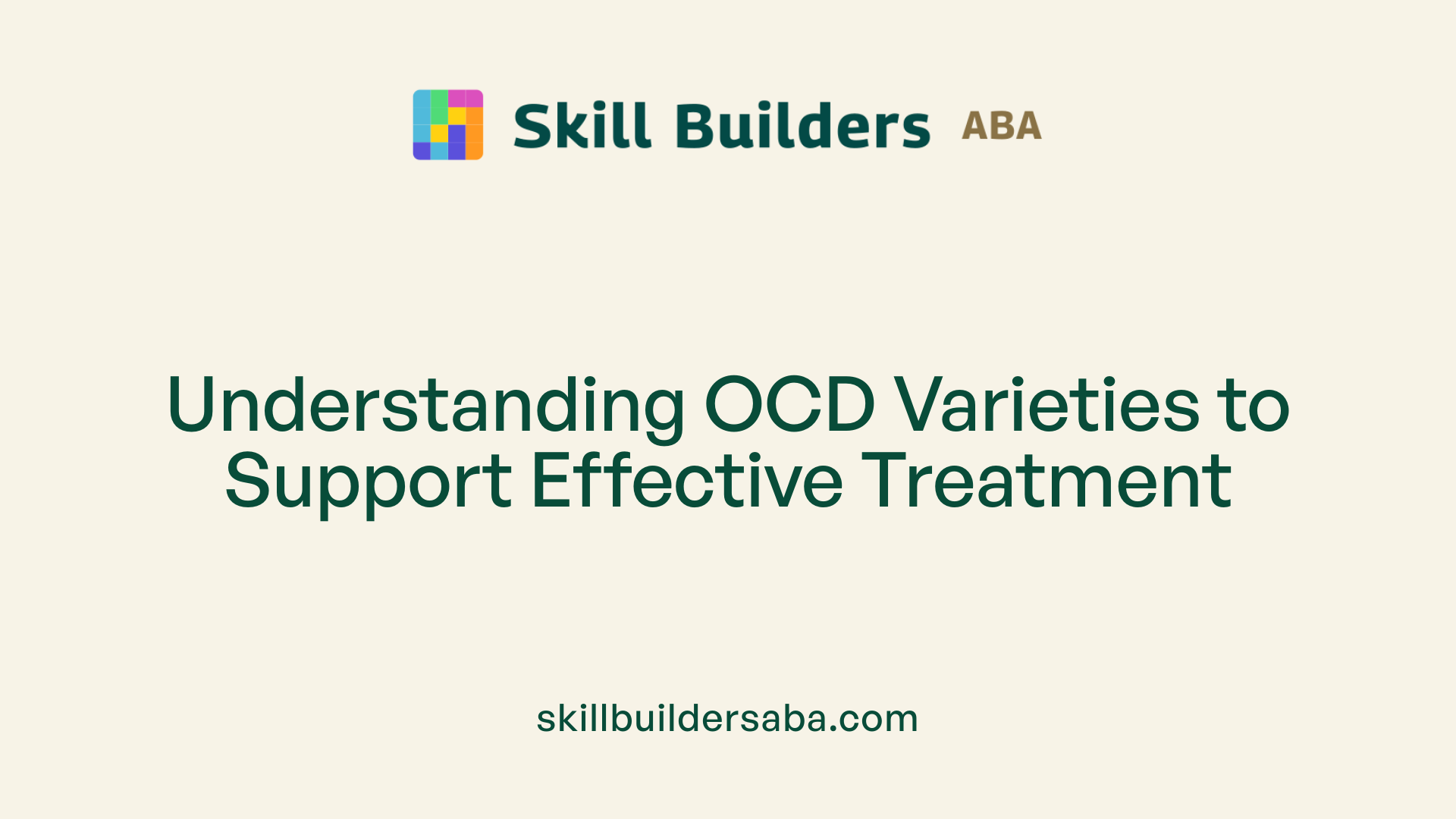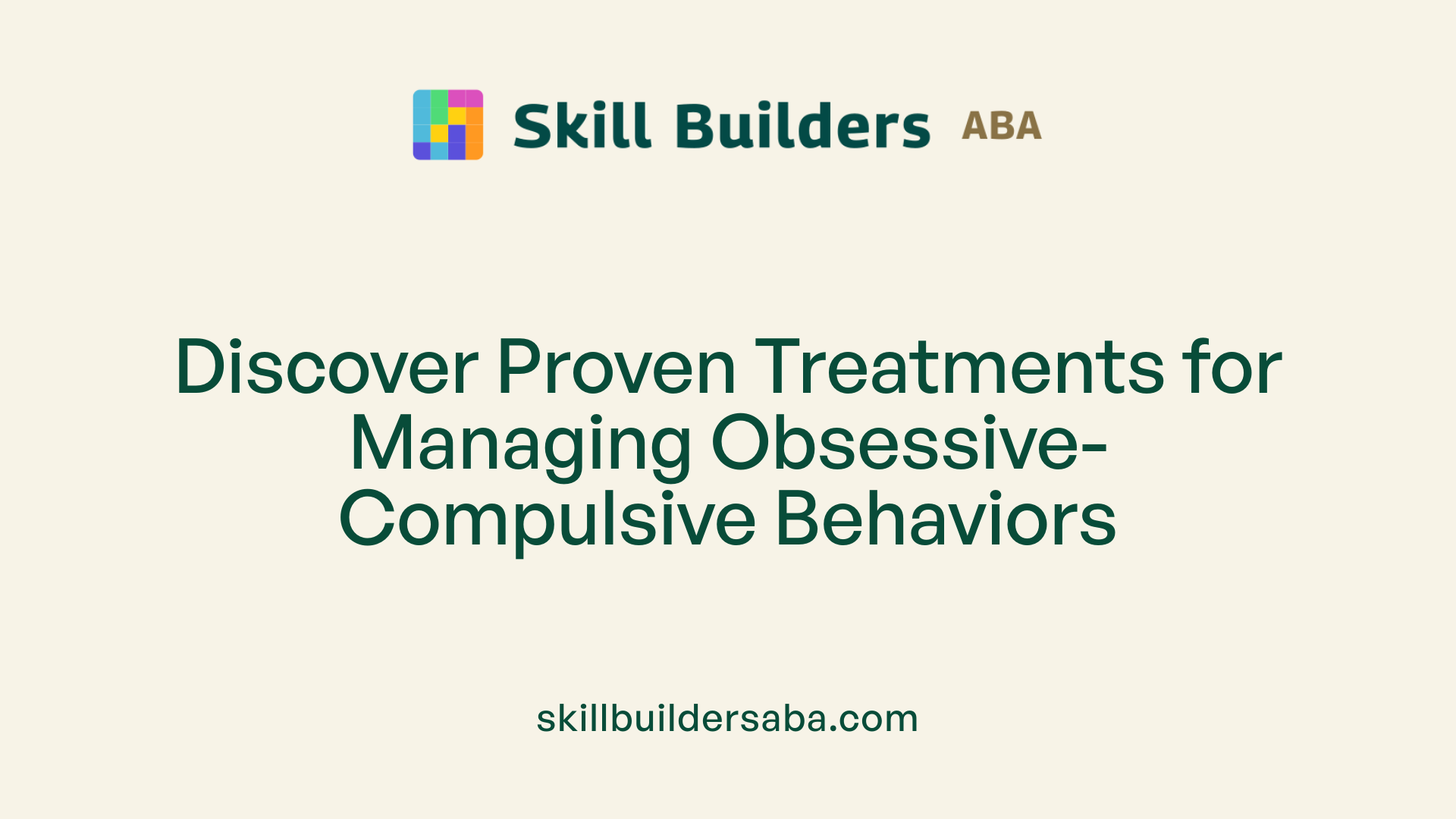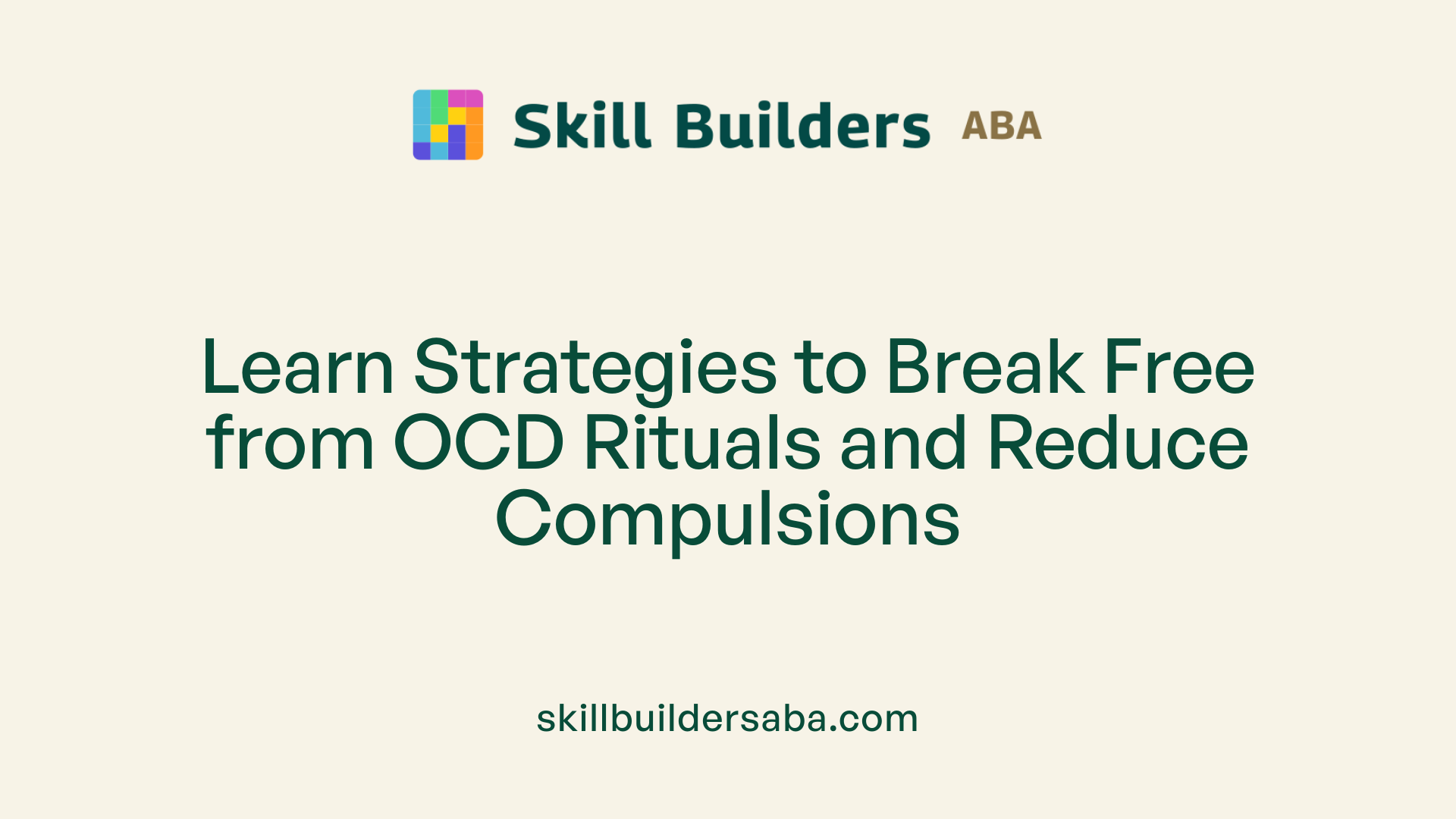
Behavioral strategies for addressing compulsive behavior
Transforming Challenges: Proven Behavioral Approaches to Manage Compulsive Actions
Understanding and Managing Compulsive Behaviors Through Effective Strategies
Compulsive behaviors can significantly impair daily functioning and well-being, but understanding the underlying mechanisms and applying targeted behavioral strategies offers hope for effective management. This article explores various therapeutic techniques, lifestyle modifications, and environmental adjustments to address the diverse spectrum of compulsive actions, highlighting the importance of professional guidance and personalized care.
Recognizing the Spectrum of Compulsive Behaviors

What are the different types of OCD?
Obsessive-Compulsive Disorder (OCD) manifests in various forms, each characterized by distinct obsessions and compulsions. The main types include Checking OCD, Contamination OCD, Symmetry and Ordering OCD, and Ruminations or Intrusive Thoughts OCD.
Checking OCD involves repeatedly verifying things like locks, appliances, or switches driven by fears of harm or disasters. This compulsive verification aims to alleviate anxiety but often perpetuates it.
Contamination OCD is marked by excessive fears of germs, dirt, or toxins, leading to compulsive cleaning, washing, or avoidance of contaminated people or places.
Symmetry and Ordering OCD entails an intense need to organize or arrange objects until a sense of balance or perfection is achieved. Rituals include lining up items or arranging them in specific ways.
Ruminations or Intrusive Thoughts OCD involves persistent, unwanted thoughts about taboo or distressing topics such as violence, harm, or sexuality. These are often accompanied by mental rituals designed to neutralize or suppress the thoughts.
Understanding these types helps in tailoring treatment, which generally combines cognitive-behavioral therapy (CBT) and medication to address specific obsessions and compulsive behaviors.
How can I help a child with compulsive behavior?
Supporting a child with compulsive behaviors requires patience, empathy, and professional guidance. It is crucial to listen carefully and avoid judgment to create a safe environment. Building trust encourages children to express their fears and compulsions without shame.
Consulting healthcare professionals, such as a child psychiatrist or psychologist, is an essential step for accurate diagnosis and suitable intervention. Evidence-based treatments like Cognitive Behavioral Therapy (CBT), particularly Exposure and Response Prevention (ERP), are highly effective in managing compulsions and reducing anxiety.
In some cases, medication such as selective serotonin reuptake inhibitors (SSRIs) may be prescribed to help control symptoms. Family involvement in therapy sessions, offering reassurance, and supporting the child's efforts to resist compulsions reinforce progress. Patience and consistency are vital, as managing compulsive behaviors is often a gradual process.
By combining professional guidance with compassionate support, caregivers can significantly improve a child’s quality of life and help them develop healthier coping mechanisms.
Core Treatments for Compulsive Behaviors

What treatment options are available for compulsive behaviors?
Managing compulsive behaviors involves a combination of therapeutic strategies and, when appropriate, medication. The selection of treatment largely depends on the underlying cause and the severity of the behaviors.
Cognitive-behavioral therapy (CBT), especially exposure and response prevention (ERP), is considered the gold standard treatment. ERP helps individuals confront anxiety-provoking stimuli without engaging in compulsive responses, gradually diminishing their urge and reducing symptoms. During therapy, individuals learn to tolerate anxiety and challenge their obsessive thoughts, leading to long-term symptom relief.
In addition to ERP, other CBT approaches like Acceptance and Commitment Therapy (ACT) focus on accepting intrusive thoughts without attempting to control them, and committing to actions aligned with personal values. Mindfulness-based techniques are also used to promote present-moment awareness, helping reduce the power of compulsive urges.
Pharmacotherapy plays an important role in treatment, particularly for conditions like OCD. Selective serotonin reuptake inhibitors (SSRIs), such as fluoxetine, fluvoxamine, paroxetine, and sertraline, often lead to significant improvement when prescribed at higher doses than standard depression treatments. These medications target the serotonin system, helping diminish obsessive thoughts and compulsive actions.
Environmental modifications and lifestyle changes can further support treatment outcomes. Reducing triggers, establishing structured daily routines, and employing stress-reduction techniques like relaxation exercises and physical activity can lessen the frequency and intensity of compulsions.
For individuals with severe or resistant symptoms, additional interventions such as repetitive transcranial magnetic stimulation (rTMS), deep brain stimulation (DBS), or even surgical procedures may be considered. Support from healthcare professionals and, often, a multidisciplinary team is crucial for developing an individualized treatment plan.
In summary, effective management of compulsive behaviors usually involves a tailored combination of behavioral therapies, medication, environmental adjustments, and support systems. Consulting with healthcare providers is essential to determine the most appropriate approach for each person.
Behavioral Interventions to Reduce Compulsions

How do you reduce compulsive behaviors?
Reducing compulsive behaviors involves a combination of awareness, strategic planning, and professional support. The first step is to recognize and notice the specific urges or thoughts that provoke these actions. Since compulsions often serve as a temporary relief from anxiety or distress, understanding their triggers is crucial.
One effective strategy is to delay or resist performing the compulsive act. For example, if you feel the urge to check something repeatedly, deliberately choosing to wait for a set amount of time before acting can weaken the compulsion over time.
Incorporating distraction techniques, such as engaging in a different activity like drawing, listening to music, or going for a walk, can divert attention away from the urge. Grounding exercises, such as focusing on the senses or using visualization techniques, help stay present and reduce overwhelming feelings.
Another approach involves acceptance—learning to sit with intrusive thoughts and feelings without acting on them or attaching unnecessary meaning. This skill reduces the power of these thoughts and diminishes their frequency.
Professional therapies like Cognitive Behavioral Therapy (CBT) combined with Exposure and Response Prevention (ERP) are proven to facilitate long-term change. These therapies help individuals confront their fears gradually and learn new responses that don't involve compulsive behaviors.
Self-care practices, including stress management, maintaining a healthy lifestyle, and joining support groups, also contribute to managing urges. Over time, these combined effort can significantly decrease the frequency and intensity of compulsions, leading to better quality of life.
How can I stop OCD rituals?
Stopping OCD rituals requires targeted behavioral strategies and often professional guidance. The most effective method is engaging in Evidence-Based Behavioral Therapy such as Exposure and Response Prevention (ERP). ERP involves gradually exposing oneself to situations that trigger OCD behaviors while actively resisting the urge to perform the ritual.
Practicing mindfulness techniques, like meditation, deep breathing, and using grounding objects, helps manage the anxiety associated with these triggers. For example, carrying a textured object or practicing mindful breathing can reduce the immediate urge to perform a ritual.
Resisting compulsions when they occur is vital; instead of giving in, delaying or reducing the ritual gradually diminishes its power. Support from family members can also be instrumental. They can help avoid accommodating OCD behaviors and support adherence to therapy plans.
Therapists often work with families to develop structured plans and family contracts, which reinforce new behaviors and reduce reinforcement of rituals.
Combining professional treatment, such as CBT and ERP, with self-care, stress reduction, and acceptance of intrusive thoughts can lead to effective management and long-term reduction of OCD rituals. Over time, these strategies help individuals regain control and improve their daily functioning.
Managing Intrusive Thoughts and Obsessions

How do you manage intrusive OCD thoughts?
Handling intrusive thoughts linked to OCD involves a combination of acceptance, mindfulness, and strategic behavioral techniques. The first step is recognizing that these thoughts are common and not indications of personal character or desires. Instead of fighting or suppressing these thoughts, which can increase distress, individuals are encouraged to accept their presence without judgment.
Cognitive-behavioral therapy, particularly exposure and response prevention (ERP), plays a central role in treatment. ERP gradually exposes individuals to the source of their anxiety while teaching them to resist compulsive responses, reducing the urge over time. Mindfulness practices, such as observing thoughts passively like clouds or leaves, further help diminish the power of intrusive images.
Grounding techniques and visualization strategies are also effective. For example, imagining OCD as a separate entity or placing intrusive thoughts in a 'mental box' can help create emotional distance. Some use visualization of thoughts as spam emails or leaves drifting away, which diminishes their significance.
In addition to these strategies, managing stress through relaxation, physical activity, good sleep, and social support can lower the frequency and intensity of intrusive OCD thoughts. It is crucial to avoid reassurance-seeking and engaging in compulsive rituals, as these actions reinforce OCD symptoms.
Consulting mental health professionals trained in OCD is essential for developing personalized coping plans. With consistent effort, many individuals find that these approaches significantly reduce their distress and improve their quality of life.
What are the 4 R's of OCD?
The 4 R's—Relabel, Reattribute, Refocus, and Revalue—are practical steps designed to help manage obsessive thoughts. Developed by psychologist Jeffrey Schwartz, this self-help framework guides individuals to identify their intrusive thoughts as false or neurobiologically driven.
Relabel involves acknowledging that these thoughts are part of OCD, not reflections of reality.
Reattribute means recognizing that these are symptoms caused by brain chemistry rather than personal flaws, easing self-blame.
Refocus encourages redirecting attention away from obsessive thoughts toward constructive activities or distractions.
Revalue helps diminish the significance of these thoughts, reducing their emotional impact.
When applied consistently, these steps empower individuals to challenge and diminish OCD’s hold on their daily lives. Combining the 4 R's with professional treatment enhances the overall management of symptoms, leading to decreased compulsive behaviors and improved functioning.
Techniques for managing intrusive thoughts and compulsions
To effectively manage intrusive thoughts and compulsions, individuals should consider a comprehensive strategy that includes:
- Recognizing and accepting intrusive thoughts without engaging with them.
- Using techniques like cognitive restructuring to question irrational beliefs.
- Employing grounding methods such as deep breathing or focusing on physical sensations.
- Visualizing thoughts as objects that can be put in a box or as leaves floating away.
- Developing healthy routines, stress reduction practices, and engaging in enjoyable activities.
- Building a strong support network to share experiences and gain reassurance.
Learning and practicing these techniques can gradually lessen the power of intrusive thoughts, reduce compulsive behaviors, and enhance overall well-being. It is important to work with mental health professionals who can tailor interventions to individual needs, ensuring a supportive and effective treatment journey.
Environmental and Lifestyle Strategies in OCD Management
How can I manage intrusive OCD thoughts?
Managing intrusive OCD thoughts requires a combination of awareness and specific strategies. The first step is recognizing and accepting these thoughts without judgment, understanding that they are common experiences and do not reflect personal desires or intents.
Cognitive-behavioral therapy (CBT), particularly exposure and response prevention (ERP), is a proven method to help individuals gradually face these unwanted thoughts. ERP involves exposing yourself to the thoughts or triggers and resisting the urge to perform compulsive behaviors, which over time can reduce the distress associated with the thoughts.
Incorporating mindfulness techniques helps by observing these thoughts non-judgmentally, allowing them to pass without engagement. Distraction strategies like engaging in hobbies, physical activity, or relaxation exercises can lessen their intensity.
Visualization techniques, such as imagining intrusive thoughts as leaves floating down a stream or emails in spam folders, can help depersonalize and diminish their impact. Maintaining a healthy lifestyle—including regular exercise, adequate sleep, and balanced diet—can also decrease overall anxiety and stress, which are common triggers.
Social support is vital; talking openly with trusted friends, family, or support groups provides reassurance and decreases feelings of isolation. It's crucial to avoid reassurance-seeking or engaging in compulsions, as these behaviors can reinforce OCD symptoms.
Consulting a mental health professional specialized in OCD can offer tailored coping strategies and ongoing support, making treatment more effective.
What are the 4 R's of OCD?
The 4 R's framework—Relabel, Reattribute, Refocus, and Revalue—serves as a practical self-help guide in managing OCD symptoms. Developed by Professor Jeffrey Schwartz, this approach helps sufferers understand that obsessive thoughts are not personal flaws but are caused by brain chemistry imbalances.
Relabel involves recognizing the intrusive thoughts as symptoms rather than truths. Reattribute means understanding these thoughts as neurobiological in origin, not a reflection of personal character.
Refocus encourages redirecting attention to engaging tasks or behaviors that distract from obsessions. Revalue involves assigning less importance to these thoughts, reducing their influence and the compulsive urge.
Implementing the 4 R's in daily life can weaken the power of obsessions and compulsions, especially when combined with professional therapies like CBT. This strategy empowers individuals to differentiate between their intrusive thoughts and reality, fostering a sense of control and helping to break the cycle of OCD.
The Role of Support Systems and Professional Help
How can I help a child with compulsive behavior?
Supporting a child with compulsive behaviors involves patience, understanding, and active involvement. It is essential to listen to the child's concerns without judgment and provide reassurance and love. Recognizing that these behaviors are often driven by anxiety or distress helps in responding compassionately.
Consulting healthcare professionals such as child psychiatrists or psychologists can provide an accurate diagnosis and tailor effective treatment strategies. Cognitive Behavioral Therapy (CBT), particularly Exposure and Response Prevention (ERP), is highly effective for children managing compulsions. This therapy gradually exposes the child to distressing stimuli while preventing the compulsive response, helping to diminish anxiety and compulsive urges.
In some cases, medication like selective serotonin reuptake inhibitors (SSRIs) might be prescribed to support behavioral therapy. Parental involvement is crucial; participating in therapy sessions, reinforcing coping strategies, and maintaining a stable routine can enhance progress. Being patient and encouraging the child's efforts fosters a supportive environment conducive to recovery.
How do you reduce compulsive behaviors?
Reducing compulsive behaviors involves a multifaceted approach focused on awareness, gradual change, and support. The first step is recognizing specific triggers or urges—identifying when and why the urge to act compulsively occurs. Understanding that compulsions often temporarily relieve anxiety can help reframe responses.
One effective strategy is to resist or delay the urge to act on compulsive behavior. Sitting with discomfort without performing the ritual gradually decreases its power. Incorporating distraction techniques, such as engaging in a creative activity, grounding exercises, or visualization, can divert attention away from the urge.
Acceptance is also vital; acknowledging intrusive thoughts without acting on them reduces their influence. Mindfulness practices teach individuals to observe thoughts non-judgmentally, decreasing emotional reactivity.
Professional therapies like CBT with ERP play a significant role in long-term management. These therapies involve systematic exposure to triggers and learning to resist compulsions, thereby reducing their frequency and intensity. Lifestyle adjustments—including stress management, regular physical activity, and social support—further assist in controlling compulsions.
Seeking ongoing support from peer groups or mental health professionals can provide encouragement and accountability. Over time, these combined efforts can lead to notable progress in managing compulsive behaviors.
Emerging and Experimental Treatments
What are the treatment options for severe or resistant compulsive behaviors?
When traditional treatments such as cognitive-behavioral therapy (CBT), exposure and response prevention (ERP), and medications like SSRIs do not sufficiently alleviate compulsive behaviors, especially in cases of severe or treatment-resistant obsessive-compulsive disorder (OCD), there are advanced interventions available.
One of these is deep brain stimulation (DBS). This technique involves surgically implanting electrodes into specific regions of the brain that are involved in regulating compulsive actions. The electrodes deliver controlled electrical impulses, which help modulate abnormal brain activity associated with compulsions. DBS is primarily used for severe OCD cases that do not respond to other treatments and requires careful consideration and management by specialized medical teams.
Another promising approach is repetitive transcranial magnetic stimulation (rTMS). This non-invasive procedure uses magnetic fields to stimulate targeted areas of the brain, particularly the prefrontal cortex, to reduce symptoms. rTMS has shown promising results in reducing obsessive thoughts and compulsive behaviors in some patients, often as part of an integrated treatment plan.
In some instances, surgical interventions such as anterior cingulotomy or capsulotomy are considered for cases where other treatments have failed. These procedures involve creating small lesions in specific brain regions to disrupt neural circuits that contribute to compulsive behaviors. While effective for some, these surgeries carry risks and are typically a last resort after exhaustive exploration of less invasive options.
Research is continuously advancing in understanding the neurobiological underpinnings of compulsive behaviors. Studies investigating brain circuits, neurotransmitter systems, and genetic factors are paving the way for more precise and personalized interventions.
Research developments
Recent research focuses on neuromodulation techniques, the use of advanced neuroimaging to better target interventions, and the development of novel pharmacotherapies. Clinical trials are exploring the potential of gene therapy, optogenetics, and more refined forms of brain stimulation.
Overall, the landscape of treatment for severe or resistant compulsive behaviors is evolving rapidly, offering hope for individuals with limited response to conventional therapies. It remains essential that such interventions are carried out under the supervision of experienced multidisciplinary teams to ensure safety and effectiveness.
| Treatment Method | Description | When It Is Used | Risks & Considerations |
|---|---|---|---|
| Deep Brain Stimulation (DBS) | Surgical implantation of electrodes to modulate brain activity | Severe, treatment-resistant OCD | Surgical risks, infection, device complications |
| Repetitive Transcranial Magnetic Stimulation (rTMS) | Non-invasive magnetic brain stimulation | Moderate to severe OCD, especially when medications fail | Headache, scalp discomfort, variable response |
| Surgical Interventions (e.g., cingulotomy) | Lesions in specific brain regions | Very severe cases unresponsive to other therapies | Permanent effects, surgical risks |
Ongoing research continues to refine these techniques, aiming for safer, more effective options tailored to individual neurobiological profiles. For updated information and detailed exploration of experimental treatments, consulting specialized medical teams and recent clinical trial data is recommended.
Incorporating Holistic and Self-Care Techniques
How can I manage intrusive OCD thoughts?
Managing intrusive OCD thoughts involves several self-help strategies aimed at reducing their frequency and intensity. The first step is to recognize and accept these thoughts without judgment, understanding that everyone experiences unwanted thoughts occasionally. Cognitive-behavioral therapy (CBT), particularly exposure and response prevention (ERP), is highly effective. It gradually exposes the individual to triggers while encouraging resistance to compulsive responses, decreasing the power of obsessive thoughts over time.
Mindfulness practices also play a crucial role. Techniques such as observing thoughts non-judgmentally or using visualization strategies—like imagining the thoughts as leaves floating away or emails being spam—can lessen their impact.
Alongside these, supporting mental health with healthy lifestyle habits is vital. Regular physical activity, proper sleep, and balanced nutrition help stabilize mood and reduce stress triggers.
Reaching out for social support, whether through trusted friends or support groups, can alleviate feelings of isolation and provide reassurance. It's important to avoid behaviors that reinforce OCD, such as reassurance seeking or engaging in compulsions.
Professional help tailored to individual needs is essential. A mental health specialist trained in OCD treatment can offer personalized tools and support your progress on the path to recovery.
What are the 4 R's of OCD?
The 4 R's—Relabel, Reattribute, Refocus, and Revalue—are a simple, effective framework developed by Professor Jeffrey Schwartz to help manage OCD symptoms. This approach encourages individuals to recognize their obsessive thoughts as false or intrusive. Relabel involves identifying these thoughts as illusions or brain-generated rather than truths.
Next, Reattribute helps reassign responsibility for these thoughts from personal flaws to neurobiological causes, reducing self-blame. Refocus redirects attention away from obsessive thoughts by engaging in alternative activities or mental exercises.
Finally, Revalue diminishes the thoughts’ significance by seeing them as just fleeting cybernetic signals that do not require action, which reduces the urge to perform compulsions.
Applying these steps consistently, especially when combined with therapy, can diminish the power of obsessive thoughts and lower compulsive behaviors. This method promotes a shift in perception—viewing obsessions as manageable symptoms of brain chemistry rather than personal failings, empowering individuals to regain control over their lives.
Strategies for a holistic approach to managing OCD
Beyond therapy and medication, adopting a holistic approach can significantly improve quality of life for those with OCD. This involves integrating relaxation, mindfulness, physical health, nutrition, sleep, and resilience practices into daily routines.
Relaxation, mindfulness, and physical health: Practices like deep breathing, progressive muscle relaxation, and mindfulness meditation can reduce overall stress levels. Regular exercise not only promotes physical health but also releases endorphins that improve mood.
Nutrition and sleep strategies: A balanced diet rich in fruits, vegetables, lean proteins, and omega-3 fatty acids supports brain health. Prioritizing consistent sleep schedules helps regulate mood and reduce anxiety triggers.
Stress management and resilience building: Developing coping skills such as time management, setting boundaries, and engaging in hobbies can buffer stress. Techniques like gratitude journaling and positive affirmations foster resilience.
Implementing these strategies creates a supportive environment that lessens OCD triggers and enhances overall well-being. Combining holistic methods with evidence-based therapy offers a comprehensive approach to managing OCD symptoms holistically.
Empowering Change Through Knowledge and Action
Addressing compulsive behaviors requires a comprehensive approach that combines evidence-based therapies, lifestyle modifications, environmental strategies, and support systems. Cognitive-behavioral therapy, particularly exposure and response prevention, remains the gold standard for many compulsive behaviors, especially OCD. Medication can augment therapy, providing symptomatic relief for some individuals. Additionally, fostering support networks, family involvement, and self-care routines enhances treatment effectiveness. Understanding one's triggers, adopting mindfulness practices, and gradually facing fears in a controlled manner can significantly reduce the hold of compulsive behaviors, improving overall quality of life and well-being. With continued research and personalized care, individuals battling compulsions can regain control and live more fulfilling lives.
References
- Tips & Advice: Managing Compulsive Behaviors | AFTD
- Compulsive Behaviors | Psychology Today
- Self-care for obsessive compulsive disorder (OCD) | Mind
- Cognitive-Behavioral Therapy for Obsessive-Compulsive Disorder
- How to Stop Compulsive Behaviors: Managing OCD
- Management Strategies for Obsessive-Compulsive Disorder - AAFP
- OCD (Obsessive-Compulsive Disorder): Symptoms & Treatment
Reach Out Today
Learn more about how we can support your child’s growth and development. Contact us to discuss our services and availability in your area.
.svg)